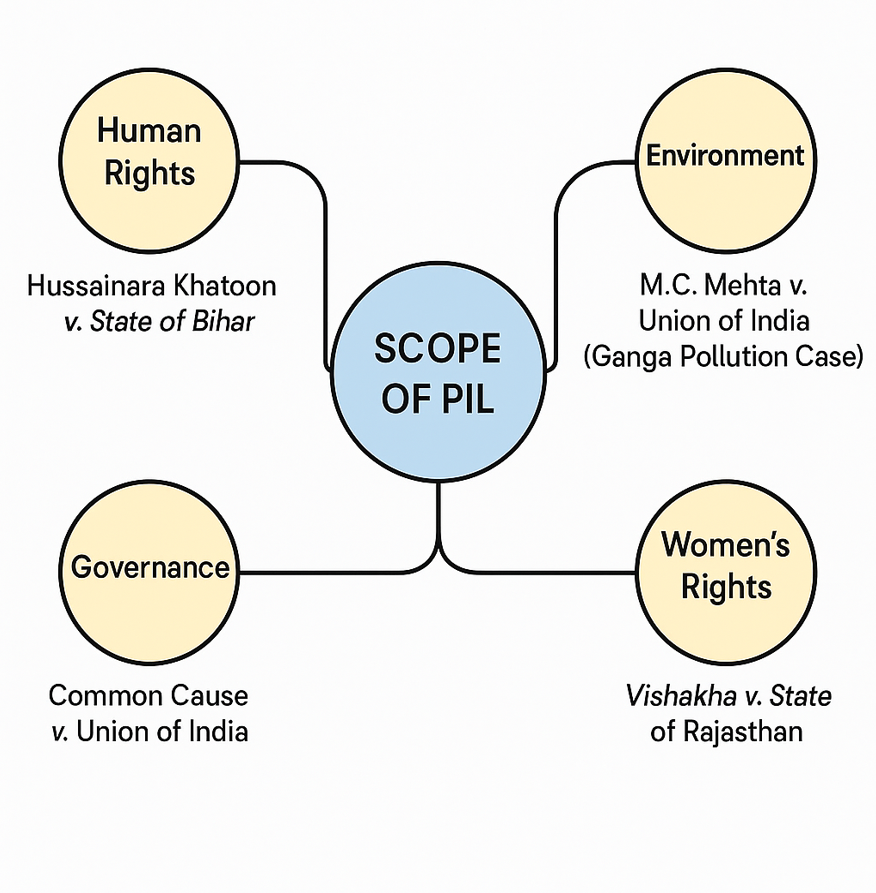There are no items in your cart
Add More
Add More
| Item Details | Price | ||
|---|---|---|---|
Mon Jun 30, 2025
పరిచయం:
ప్రజా ప్రయోజన వ్యాజ్యం (PIL) అనేది 1979లో హుస్సైనారా ఖాతూన్ వర్సెస్ స్టేట్ ఆఫ్ బీహార్ కేసు ద్వారా న్యాయపరంగా అభివృద్ధి చేయబడిన ఒక సాధనం. ఇది వ్యక్తులు లేదా సమూహాలు ప్రజా సంక్షేమాన్ని ప్రభావితం చేసే విషయాలలో న్యాయపరమైన పరిష్కారాలను కోరడానికి అనుమతిస్తుంది. రాజ్యాంగంలోని 32 మరియు 226 అధికరణలలో ఉన్న ఈ విధానం, సామాజిక, పర్యావరణ, మరియు రాజ్యాంగ సంబంధిత కారణాల కోసం న్యాయస్థానాలు జోక్యం చేసుకునేందుకు అధికారం ఇస్తూ న్యాయాన్ని ప్రజాస్వామ్యీకరిస్తుంది.
విషయం:
ఎ. PIL యొక్క న్యాయపరమైన పునాది మరియు పరిణామం
1. రాజ్యాంగ రిట్ అధికారం
a. అధికరణ 32 (సుప్రీం కోర్టు) మరియు అధికరణ 226 (హైకోర్టులు) ఆధారంగా.
b. ప్రాథమిక హక్కుల అమలు మరియు ప్రజా విధుల కోసం రిట్ల జారీని అనుమతిస్తుంది.
c. చట్టంలో నిర్వచించబడలేదు, కానీ న్యాయపరమైన వివరణ ద్వారా అభివృద్ధి చేయబడింది.
2. లోకస్ స్టాండీ యొక్క సడలింపు
a. సాంప్రదాయ నియమం పిటిషన్లను నేరుగా ప్రభావితమైన వ్యక్తులకు పరిమితం చేసింది.
b. ఎస్.పి. గుప్తా వర్సెస్ యూనియన్ ఆఫ్ ఇండియా (1981) కేసులో, న్యాయస్థానం ప్రజా ఆసక్తి కోసం మూడవ పక్ష పిటిషన్లను అనుమతించింది.
c. అట్టడుగు మరియు గొంతు లేని వర్గాలకు న్యాయస్థాన అనుమతిని అందించింది.
3. పూర్వ నిర్ణయాల ద్వారా న్యాయపరమైన గుర్తింపు
a. హుస్సైనారా ఖాతూన్ వర్సెస్ స్టేట్ ఆఫ్ బీహార్ (1979)లో, ఒక పోస్ట్కార్డ్ ద్వారా 40,000 మంది అండర్ట్రయల్ ఖైదీల విడుదలకు దారితీసింది.
b. న్యాయస్థానం వేగవంతమైన విచారణను అధికరణ 21లో భాగంగా గుర్తించింది.
4. స్వయం ప్రవర్తిత అధికారం (సువో మోటు)
a. లేఖలు లేదా మీడియా నివేదికల ఆధారంగా న్యాయస్థానాలు అధికారిక పిటిషన్లు లేకుండా కేసులను స్వీకరిస్తాయి.
b. ఇది న్యాయస్థానాల సక్రియ జోక్యాన్ని ప్రతిబింబిస్తుంది.
c. ఉదాహరణ: మోర్బీ వంతెన కూలడం (2022)ను గుజరాత్ హైకోర్టు సువో మోటు స్వీకరించింది.
బి. PIL కేసులలో న్యాయస్థాన ఆదేశాల స్వభావం
1. నిర్దేశక మరియు నిర్మాణాత్మక ఆదేశాలు
a. న్యాయస్థానాలు కార్యనిర్వాహక విధులను ప్రభావితం చేసే వ్యవస్థాగత ఆదేశాలు జారీ చేస్తాయి.
b. బంధువ ముక్తి మోర్చాలో, న్యాయస్థానం బానిస శ్రామికుల పునరావాసాన్ని నిర్ధారించింది.
c. ఆదేశాలలో సమయపాలన మరియు సంస్థాగత బాధ్యతలు ఉంటాయి.
2. విధానపరమైన నిర్మాణ మార్గదర్శకాలు
a. చట్టపరమైన శూన్యతలను న్యాయస్థానాలు బంధనాత్మక నిబంధనల ద్వారా భర్తీ చేస్తాయి.
b. విశాఖ వర్సెస్ స్టేట్ ఆఫ్ రాజస్థాన్ (1997)లో, కార్యస్థలంలో లైంగిక వేధింపులపై మార్గదర్శకాలు రూపొందించబడ్డాయి.
c. తర్వాత ఇవి 2013 లైంగిక వేధింపుల చట్టంగా కోడిఫై చేయబడ్డాయి.
3. నిరంతర మాండమస్
a. అమలు పర్యవేక్షణ కోసం న్యాయస్థానాలు కేసులను తెరిచి ఉంచి, ఆవర్తన సమీక్షలు నిర్వహిస్తాయి.
b. ఎంసీ మెహతా కేసులలో గంగా కాలుష్యం మరియు ఢిల్లీ వాయు నాణ్యతపై ఇది కనిపిస్తుంది. c. దీర్ఘకాల న్యాయ పర్యవేక్షణను నిర్ధారిస్తుంది.
4. అత్యవసర సువో మోటు ఉపశమనం
a. పరిపాలనా వైఫల్యాలు లేదా ప్రజా సంక్షోభాల సమయంలో న్యాయస్థానాలు చర్య తీసుకుంటాయి.
b. ఉదాహరణ: మోర్బీ వంతెన కూలడం (2022)లో, న్యాయస్థానం అధికారిక పిటిషన్ లేకుండా జవాబుదారీతనం కోరింది.
c. ఇది వేగవంతమైన ప్రతిస్పందన మరియు సంస్థాగత పరిష్కారాన్ని నిర్ధారిస్తుంది.
5. దుర్వినియోగ నిరోధక చర్యలు
a. సుప్రీం కోర్టు మార్గదర్శకాల (1998 & 2003) ప్రకారం, పిటిషనర్ యొక్క ఆధారాలు మరియు ఉద్దేశ్యాన్ని న్యాయస్థానాలు అంచనా వేయాలి.
b. అసంబద్ధ లేదా రాజకీయ ప్రేరేపిత పిటిషన్లు తిరస్కరణకు గురవుతాయి.
c. PIL దుర్వినియోగాన్ని నిరోధించడానికి న్యాయస్థానాలు దండనాత్మక ఖర్చులను విధించవచ్చు.

ముగింపు
PIL గొంతు లేని వారి గొంతుకను బలోపేతం చేయడం ద్వారా రాజ్యాంగ పరిపాలనను బలోపేతం చేసింది. రెండవ పరిపాలన సంస్కరణల కమిషన్ చెప్పినట్లుగా, న్యాయపరమైన సంయమనం, విధానపరమైన తనిఖీలు, మరియు ఉద్దేశ్య నిజాయితీ ద్వారా దాని ప్రభావాన్ని సంరక్షించాలి. ఇది సంస్థాగత జవాబుదారీతనానికి మరియు సంపూర్ణ న్యాయం అనే రాజ్యాంగ లక్ష్యాన్ని నెరవేర్చే సాధనంగా వృద్ధి చేయాలి.